Recovery of Magnetic Ni Particles from Spent Catalyst Leachate by Direct Cementation
Abstract
:1. Introduction
2. Materials and Methods
2.1. Cementation Experiments
2.2. Characterization of Nickel Particles
3. Thermodynamics
4. Results and Discussion
4.1. Characterization of Cemented Ni
4.2. Statistical Model and ANOVA Analysis
4.3. Response Surface Analysis
5. Conclusions
Author Contributions
Funding
Institutional Review Board Statement
Informed Consent Statement
Data Availability Statement
Conflicts of Interest
Appendix A
| Temp. (°C) | 3Ni2+ + 2Al = 2Al3+ + 3Ni | Ni + 2HCl = H2(g) + NiCl2 | 2Al + 6HCl = 2AlCl3 + 3H2(g) | |||
|---|---|---|---|---|---|---|
| ∆G (kJ) | ∆H (kJ) | ∆G (kJ) | ∆H (kJ) | ∆G (kJ) | ∆H (kJ) | |
| 0 | −852.4 | −913.6 | −0.1 | 51.4 | −995.4 | −973.1 |
| 5 | −851.3 | −914.0 | −1.1 | 50.3 | −995.7 | −981.0 |
| 10 | −850.1 | −914.4 | −2.0 | 49.3 | −995.9 | −988.5 |
| 15 | −849.0 | −914.7 | −2.9 | 48.3 | −996.0 | −996.0 |
| 20 | −847.8 | −915.1 | −3.8 | 47.4 | −995.9 | −1003.3 |
| 25 | −846.7 | −915.4 | −4.6 | 46.6 | −995.8 | −1010.5 |
| 30 | −845.5 | −915.7 | −5.5 | 45.8 | −995.5 | −1017.7 |
| 35 | −844.4 | −916.1 | −6.3 | 45.0 | −995.0 | −1024.9 |
| 40 | −843.2 | −916.4 | −7.1 | 44.2 | −994.5 | −1032.2 |
| 45 | −842.0 | −916.7 | −8.0 | 43.4 | −993.8 | −1039.4 |
| 50 | −840.9 | −917.0 | −8.8 | 42.6 | −993.1 | −1046.8 |
| 55 | −839.7 | −917.3 | −9.6 | 41.9 | −992.2 | −1054.1 |
| 60 | −838.5 | −917.6 | −10.3 | 41.1 | −991.2 | −1061.6 |
| 65 | −837.3 | −918.0 | −11.1 | 40.3 | −990.1 | −1069.1 |
| 70 | −836.1 | −918.3 | −11.9 | 39.6 | −988.8 | −1076.6 |
| 75 | −834.9 | −918.6 | −12.6 | 38.8 | −987.5 | −1084.3 |
| 80 | −833.7 | −919.0 | −13.3 | 38.0 | −986.0 | −1092.0 |
| 85 | −832.5 | −919.3 | −14.0 | 37.3 | −984.5 | −1099.8 |
| 90 | −831.3 | −919.7 | −14.8 | 36.5 | −982.8 | −1107.7 |
| 95 | −830.1 | −920.0 | −15.5 | 35.7 | −981.1 | −1115.7 |
| 100 | −828.8 | −920.4 | −16.2 | 34.9 | −979.2 | −1123.8 |
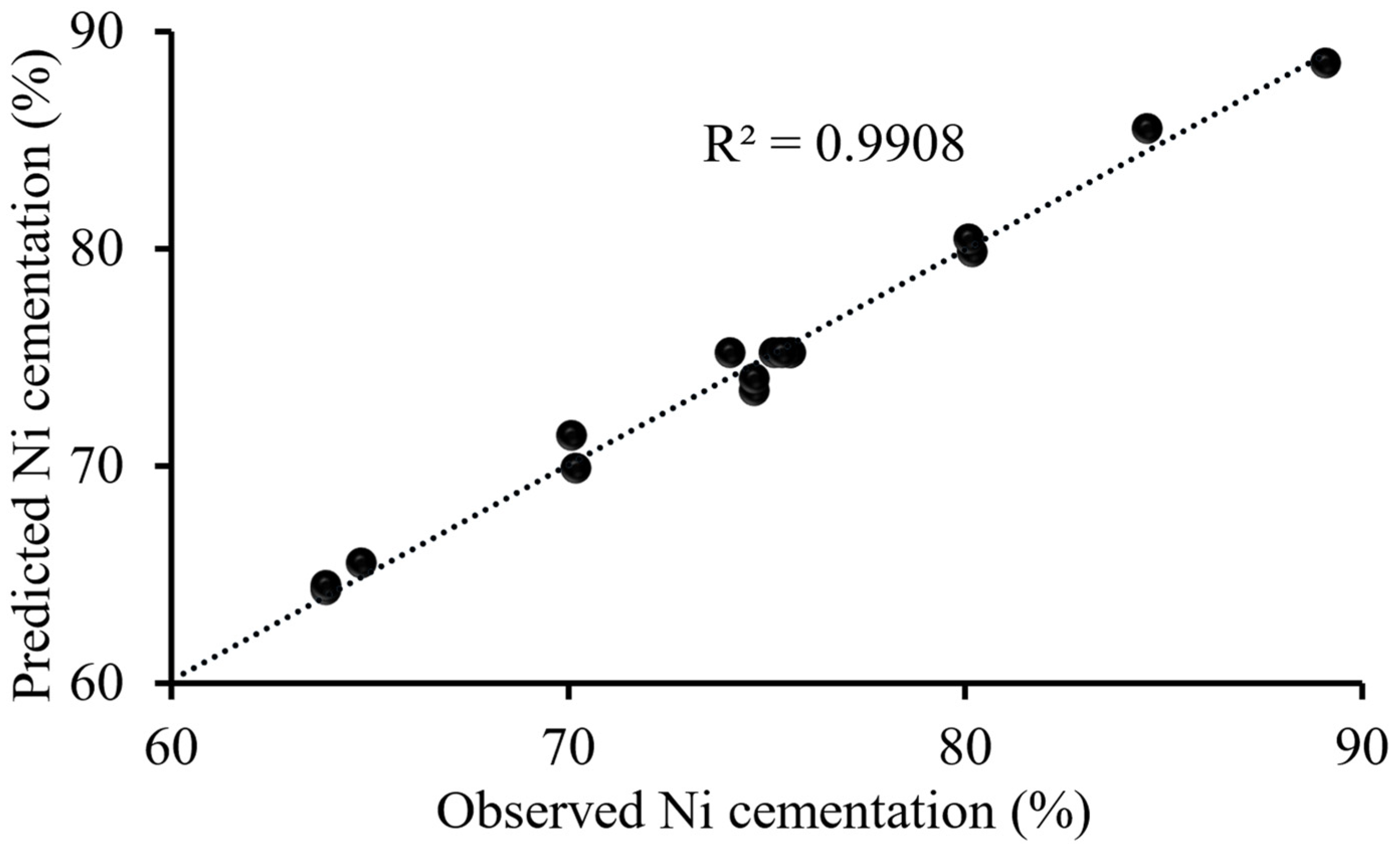
References
- Moosakazemi, F.; Ghassa, S.; Jafari, M.; Chelgani, S.C. Bioleaching for Recovery of Metals from Spent Batteries—A Review. Miner. Process. Extr. Metall. Rev. 2023, 44, 511–521. [Google Scholar] [CrossRef]
- Razazan, F.; Abdollahi, H.; Doulati Ardejani, F.; Gharabaghi, M.; Ghassa, S. Synthesizing of Magnesium and Nickel Nanoparticles from Spent Methane Dry Reforming Catalyst Using Sol–Gel Method: Process Flow Diagram Development. J. Mater. Cycles Waste Manag. 2023, 25, 1645–1657. [Google Scholar] [CrossRef]
- Rezaei, H.; Shafaei, S.Z.; Abdollahi, H.; Ghassa, S.; Boroumand, Z.; Fallah Nosratabad, A. Spent-Medium Leaching of Germanium, Vanadium and Lithium from Coal Fly Ash with Biogenic Carboxylic Acids and Comparison with Chemical Leaching. Hydrometallurgy 2023, 217, 106038. [Google Scholar] [CrossRef]
- Wen, J.; Wang, X.; Yu, F.; Tian, M.; Wang, C.; Huang, G.; Xu, S. Recovery and Value-Added Utilization of Critical Metals from Spent Catalysts for New Energy Industry. J. Clean. Prod. 2023, 419, 138295. [Google Scholar] [CrossRef]
- Trinh, H.B.; Lee, J.C.; Suh, Y.J.; Lee, J. A review on the recycling processes of spent auto-catalysts: Towards the development of sustainable metallurgy. Waste Manag. 2020, 114, 148–165. [Google Scholar] [CrossRef]
- Li, M.; Liu, B.; Wang, X.; Yu, X.; Zheng, S.; Du, H.; Dreisinger, D.; Zhang, Y. A promising approach to recover a spent SCR catalyst: Deactivation by arsenic and alkaline metals and catalyst regeneration. Chem. Eng. J. 2018, 342, 1–8. [Google Scholar] [CrossRef]
- Wiecka, Z.; Rzelewska-Piekut, M.; Cierpiszewski, R.; Staszak, K.; Regel-Rosocka, M. Hydrometallurgical Recovery of Cobalt(II) from Spent Industrial Catalysts. Catalysts 2020, 10, 61. [Google Scholar] [CrossRef]
- Marafi, M.; Stanislaus, A. Studies on Recycling and Utilization of Spent Catalysts: Preparation of Active Hydrodemetallization Catalyst Compositions from Spent Residue Hydroprocessing Catalysts. Appl. Catal. B Environ. 2007, 71, 199–206. [Google Scholar] [CrossRef]
- Keersemaker, M. Critical Raw Materials. In Suriname Revisited: Economic Potential of Its Mineral Resources; SpringerBriefs in Earth Sciences; Springer: Cham, Switzerland, 2020; pp. 69–82. ISBN 978-3-030-40268-6. [Google Scholar] [CrossRef]
- Elshkaki, A.; Graedel, T.E.; Ciacci, L.; Reck, B.K. Resource Demand Scenarios for the Major Metals. Environ. Sci. Technol. 2018, 52, 2491–2497. [Google Scholar] [CrossRef] [PubMed]
- Xia, J.; Ghahreman, A. Platinum Group Metals Recycling from Spent Automotive Catalysts: Metallurgical Extraction and Recovery Technologies. Sep. Purif. Technol. 2023, 311, 123357. [Google Scholar] [CrossRef]
- Liang, G.; Qu, Z. Insight into Pyrometallurgical Recovery of Platinum Group Metals from Spent Industrial Catalyst: Co-Disposal of Industrial Wastes. ACS ES&T Eng. 2023, 3, 1532–1546. [Google Scholar] [CrossRef]
- Kurniawan, K.; Kim, S.; Bae, M.; Lee, H.; Lee, J. A Review on the Metallurgical Recycling Process of Vanadium from Secondary Resources. Miner. Process. Extr. Metall. Rev. 2023, 2023, 1–31. [Google Scholar] [CrossRef]
- Liu, C.; Sun, S.; Zhu, X.; Tu, G. Metals Smelting-Collection Method for Recycling of Platinum Group Metals from Waste Catalysts: A Mini Review. Waste Manag. Res. 2021, 39, 43–52. [Google Scholar] [CrossRef]
- Saguru, C.; Ndlovu, S.; Moropeng, D. A Review of Recent Studies into Hydrometallurgical Methods for Recovering PGMs from Used Catalytic Converters. Hydrometallurgy 2018, 182, 44–56. [Google Scholar] [CrossRef]
- Moosakazemi, F.; Tavakoli Mohammadi, M.R.; Zakeri, M.; Esmaeili, M.J.; Rafiei, H. Development of an Environmentally Friendly Flowsheet for the Hydrometallurgical Recovery of Nickel and Aluminum from Spent Methanation Catalyst. J. Clean. Prod. 2020, 244, 118731. [Google Scholar] [CrossRef]
- Paiva, A.P. Recycling of Palladium from Spent Catalysts Using Solvent Extraction—Some Critical Points. Metals 2017, 7, 505. [Google Scholar] [CrossRef]
- Gao, B.; Jiang, H.; Zeng, M.; Peng, M.; Hu, L.; Zhang, W.; Mao, L. High-Efficiency Recycling Method for Mo and Ni from Spent Catalyst via Soda Roasting and Solvent Extraction. J. Clean. Prod. 2022, 367, 132976. [Google Scholar] [CrossRef]
- Asrami, M.R.; Tran, N.N.; Nigam, K.D.P.; Hessel, V. Solvent Extraction of Metals: Role of Ionic Liquids and Microfluidics. Sep. Purif. Technol. 2021, 262, 118289. [Google Scholar] [CrossRef]
- Binnemans, K.; Jones, P.T. Solvometallurgy: An Emerging Branch of Extractive Metallurgy. J. Sustain. Metall. 2017, 3, 570–600. [Google Scholar] [CrossRef]
- Alvial-Hein, G.; Mahandra, H.; Ghahreman, A. Separation and Recovery of Cobalt and Nickel from End of Life Products via Solvent Extraction Technique: A Review. J. Clean. Prod. 2021, 297, 126592. [Google Scholar] [CrossRef]
- Lewis, A.E. Review of Metal Sulphide Precipitation. Hydrometallurgy 2010, 104, 222–234. [Google Scholar] [CrossRef]
- Lee, J.Y.; Rao, S.V.; Kumar, B.N.; Kang, D.J.; Reddy, B.R. Nickel Recovery from Spent Raneynickel Catalyst through Dilute Sulfuric Acid Leaching and Soda Ash Precipitation. J. Hazard. Mater. 2010, 176, 1122–1125. [Google Scholar] [CrossRef]
- Demirkiran, N.; Ekmekyapar, A.; Künkül, A.; Baysar, A. A Kinetic Study of Copper Cementation with Zinc in Aqueous Solutions. Int. J. Miner. Process. 2007, 82, 80–85. [Google Scholar] [CrossRef]
- Nie, Y.; Wang, S.; Wang, Q.; Chen, J.; Jiang, Y. Applying an External Reduction Potential to Reduce the Consumption of Zinc Powder during Gold Cementation. Miner. Eng. 2023, 191, 107981. [Google Scholar] [CrossRef]
- Shishkin, A.; Mironovs, V.; Vu, H.; Novak, P.; Baronins, J.; Polyakov, A.; Ozolins, J. Cavitation-Dispersion Method for Copper Cementation from Wastewater by Iron Powder. Metals 2018, 8, 920. [Google Scholar] [CrossRef]
- Noubactep, C. Elemental Metals for Environmental Remediation: Learning from Cementation Process. J. Hazard. Mater. 2010, 181, 1170–1174. [Google Scholar] [CrossRef]
- Ebrahimi, E.; Abdollahi, H.; Ziaedin Shafaei, S.; Ghanbarzad, M.; Talebi, E. Green Extraction of Pure Ferromagnetic Nickel from Spent Hydroprocessing Catalysts via Deep Eutectic Solvents. Sep. Purif. Technol. 2023, 313, 123461. [Google Scholar] [CrossRef]
- Moosakazemi, F.; Ghassa, S.; Soltani, F.; Tavakoli Mohammadi, M.R. Regeneration of Sn-Pb Solder from Waste Printed Circuit Boards: A Hydrometallurgical Approach to Treating Waste with Waste. J. Hazard. Mater. 2020, 385, 121589. [Google Scholar] [CrossRef]
- Myers, R.H.; Montgomery, D.C.; Anderson-Cook, C.M. Response Surface Methodology: Process and Product Optimization Using Designed Experiments, 3rd ed.; Wiley Series in Probability and Statistics; Wiley: New York, NY, USA, 2009. [Google Scholar]
- Illés, I.B.; Kékesi, T. Efficient Deposition of Indium by Cementation from Chloride Solutions. Hydrometallurgy 2022, 208, 105806. [Google Scholar] [CrossRef]
- London Metal Exchange. Available online: https://www.lme.com/ (accessed on 9 May 2023).
- García-Cerda, L.A.; Bernal-Ramos, K.M.; Montemayor, S.M.; Quevedo-López, M.A.; Betancourt-Galindo, R.; Bueno-Báques, D. Preparation of Hcp and Fcc Ni and Ni/NiO Nanoparticles Using a Citric Acid Assisted Pechini-Type Method. J. Nanomater. 2011, 2011, 162495. [Google Scholar] [CrossRef]
- Cullity, B.; Graham, C. Introduction to Magnetic Materials; John Wiley & Sons, Inc.: Hoboken, NJ, USA, 2011. [Google Scholar]
- Liu, C.M.; Guo, L.; Wang, R.M.; Deng, Y.; Xu, H.; Yang, S. Magnetic Nanochains of Metal Formed by Assembly of Small Nanoparticles. Chem. Commun. 2004, 23, 2726–2727. [Google Scholar] [CrossRef]
- Nogués, J.; Schuller, I.K. Exchange Bias. J. Magn. Magn. Mater. 1999, 192, 203–232. [Google Scholar] [CrossRef]
- Yao, Y.D.; Chen, Y.Y.; Tai, M.F.; Wang, D.H.; Lin, H.M. Magnetic Anisotropy Effects in Nano-Cluster Nickel Particles. Mater. Sci. Eng. A 1996, 217–218, 281–285. [Google Scholar] [CrossRef]
- Fraune, M.; Rüdiger, U.; Güntherodt, G.; Cardoso, S.; Freitas, P. Size Dependence of the Exchange Bias Field in NiO/Ni Nanostructures. Appl. Phys. Lett. 2000, 77, 3815–3817. [Google Scholar] [CrossRef]
- Kodama, R.H.; Makhlouf, S.A.; Berkowitz, A.E. Finite Size Effects in Antiferromagnetic NiO Nanoparticles. Phys. Rev. Lett. 1997, 79, 1393. [Google Scholar] [CrossRef]
- Moosakazemi, F.; Tavakoli Mohammadi, M.R.; Mohseni, M.; Karamoozian, M.; Zakeri, M. Effect of Design and Operational Parameters on Particle Morphology in Ball Mills. Int. J. Miner. Process. 2017, 165, 41–49. [Google Scholar] [CrossRef]

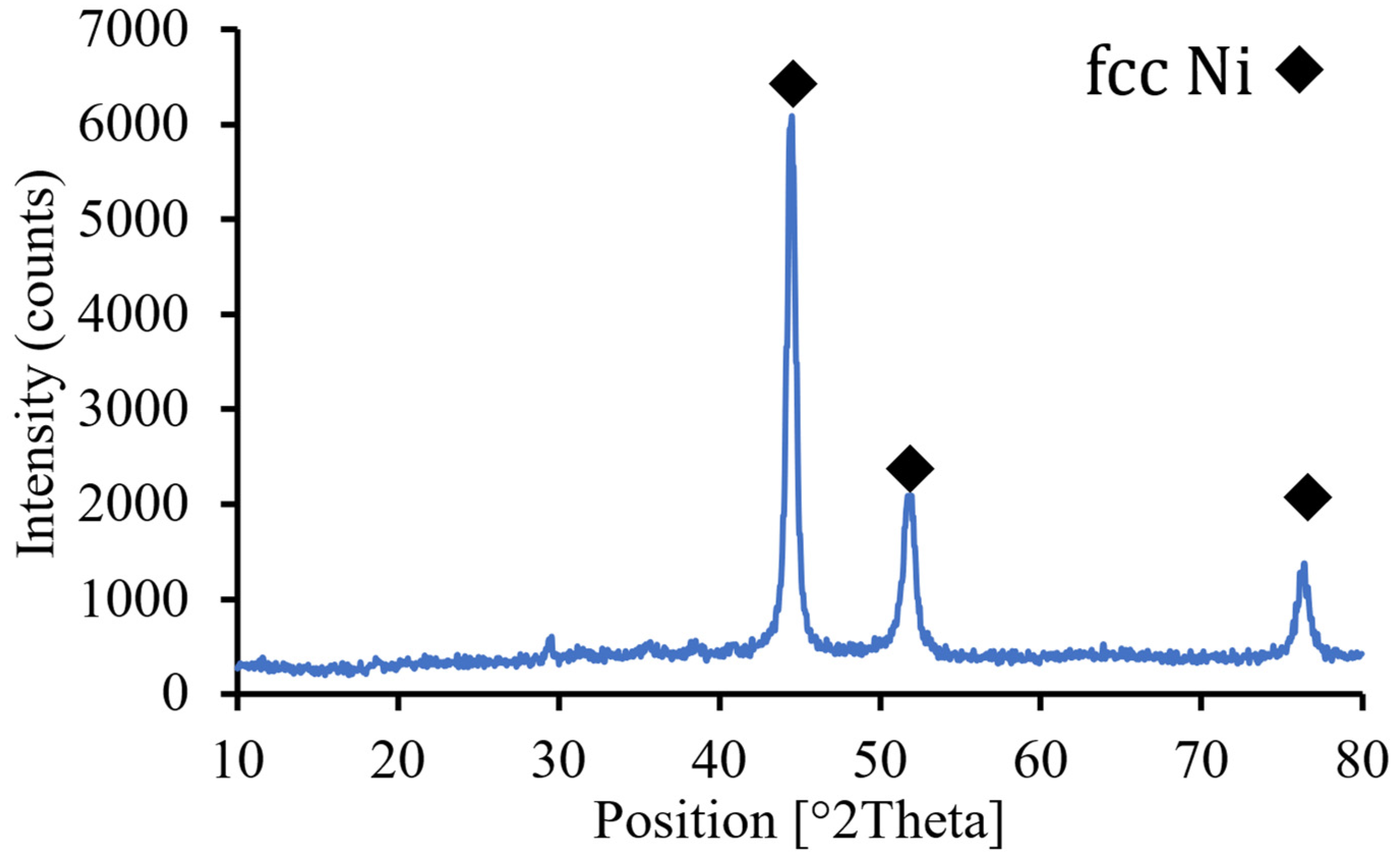
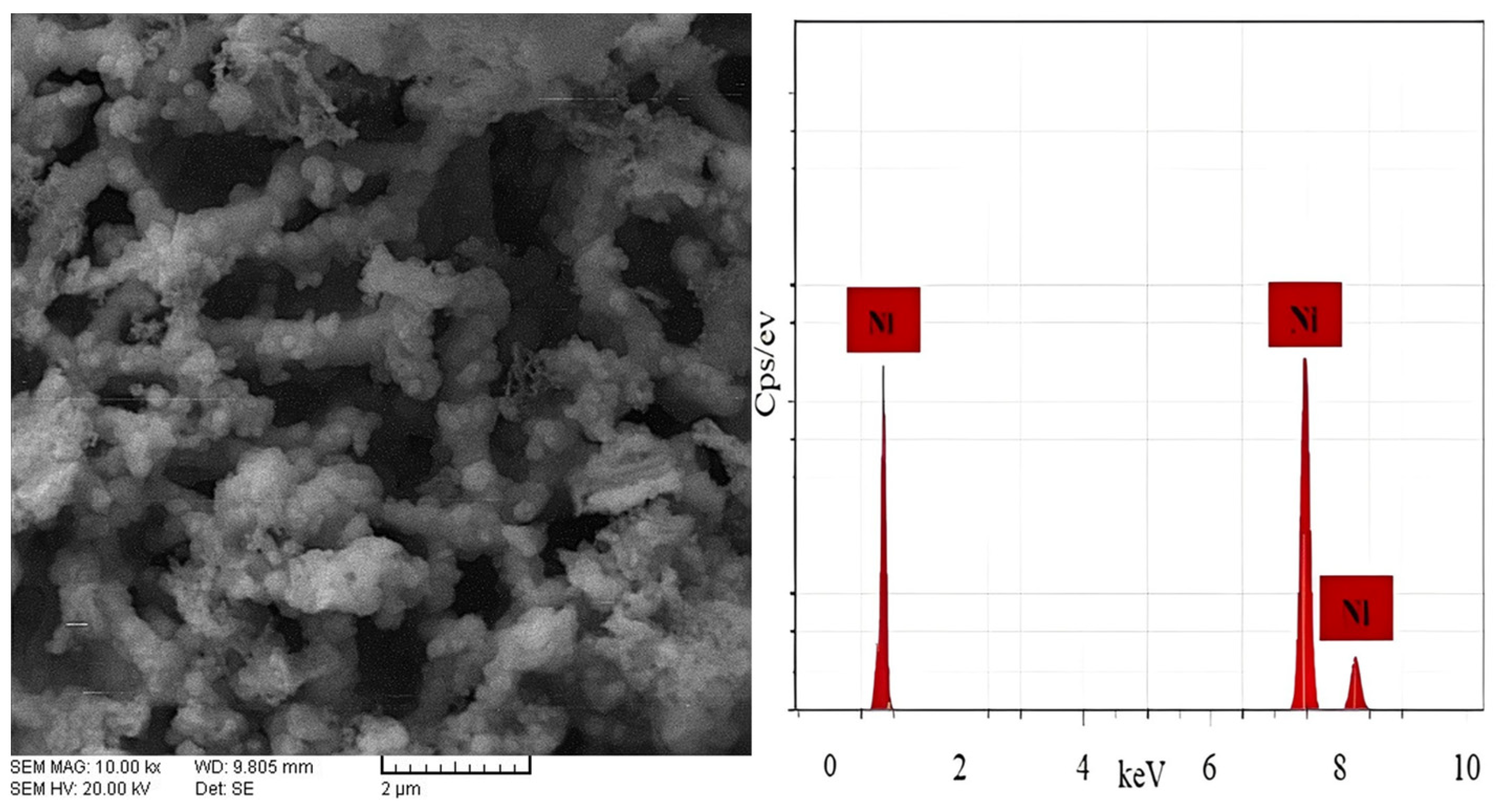
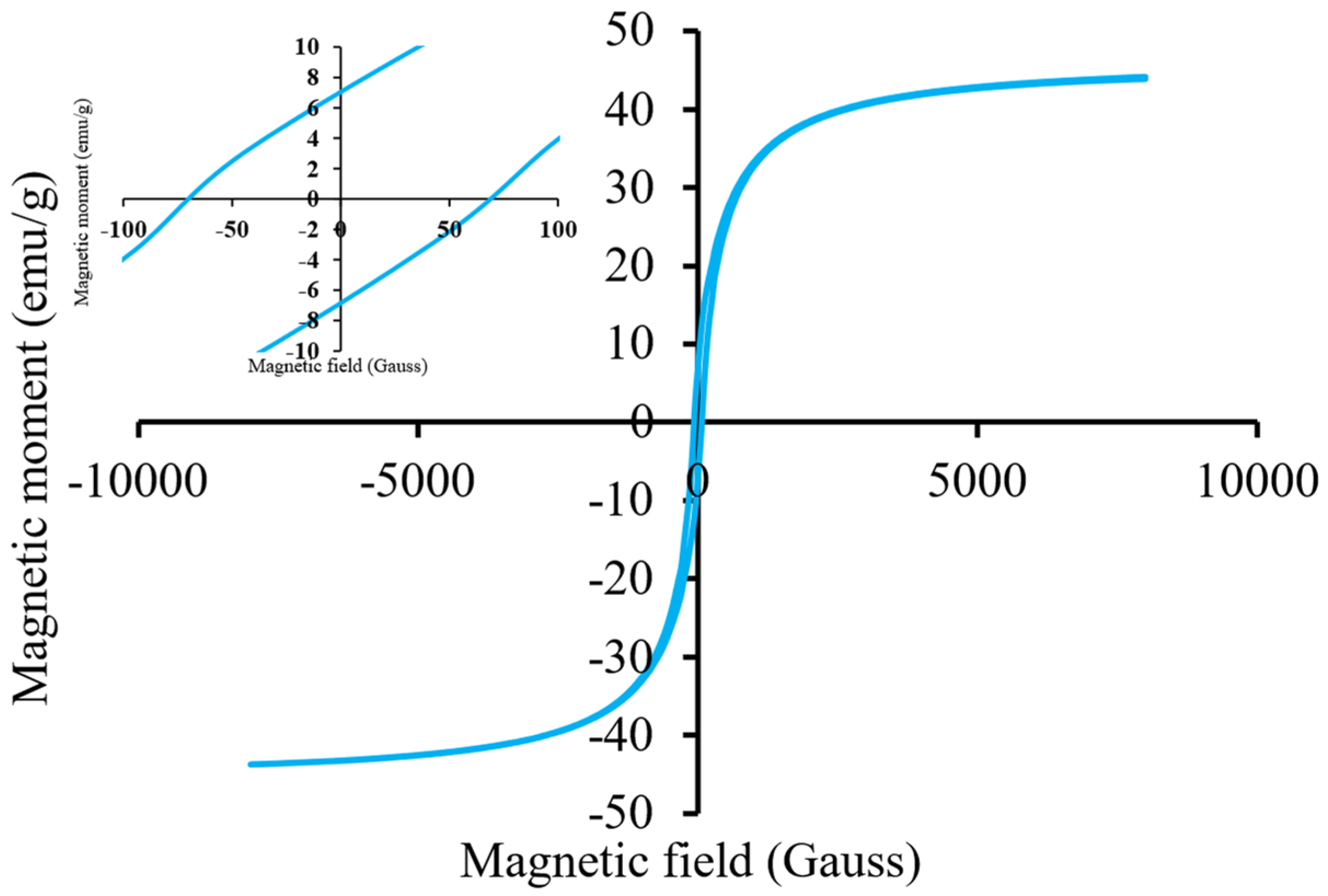
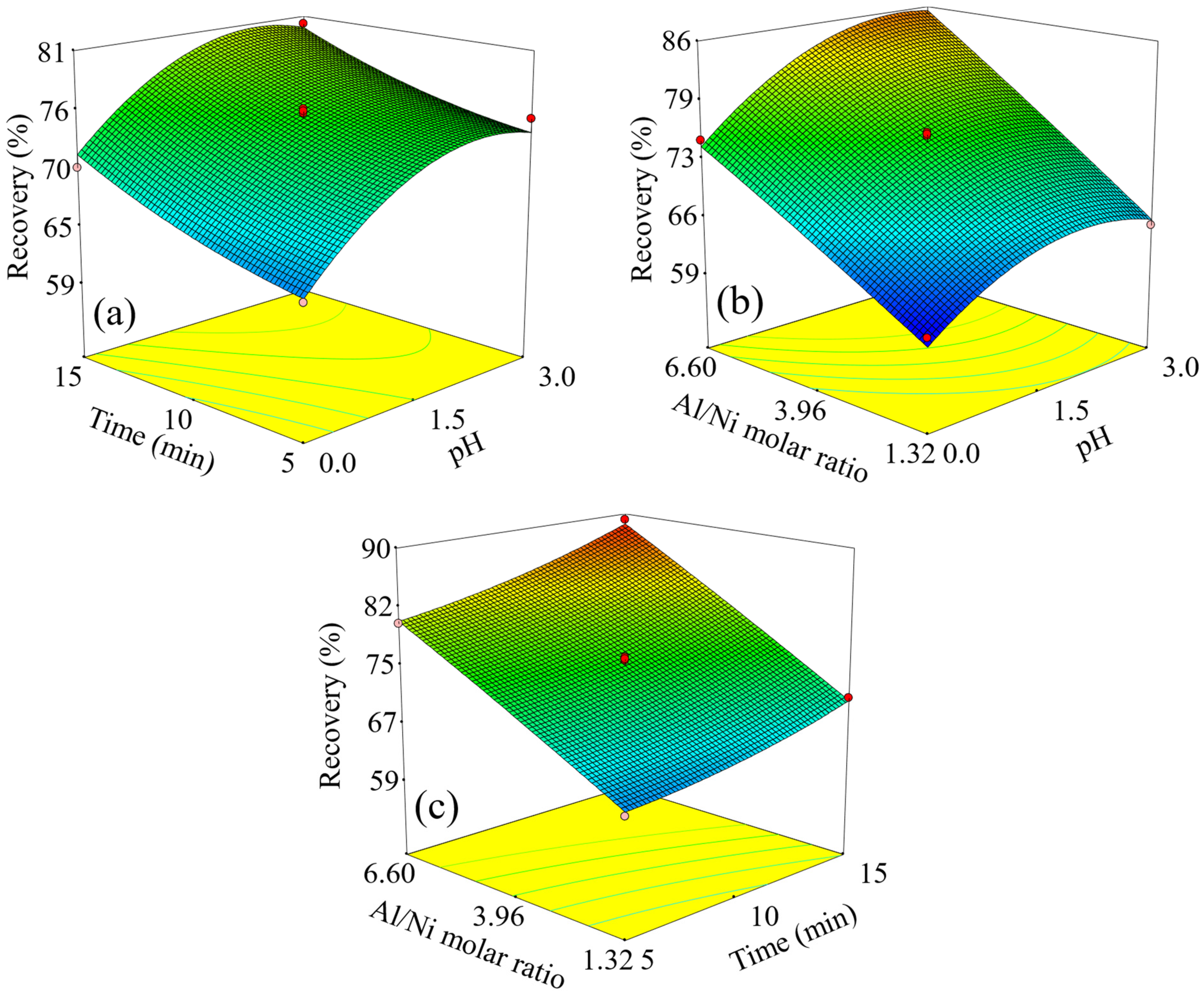
| Actual Variables | Coded Variables | Levels | ||
|---|---|---|---|---|
| −1 | 0 | +1 | ||
| pH | A | 0 | 2 | 3 |
| Reaction time (min) | B | 5 | 10 | 15 |
| Al/Ni ratio (mol/mol) | C | 1.32 (3) * | 3.96 (9) * | 6.60 (15) * |
| Run | Coded Factors | Ni Recovery (%) | |||
|---|---|---|---|---|---|
| A | B | C | Actual | Predicted | |
| 1 | −1.0 | 0.0 | 1.0 | 74.7 | 73.4 |
| 2 | −1.0 | 1.0 | 0.0 | 70.1 | 71.4 |
| 3 | 0.0 | 0.0 | 0.0 | 75.6 | 75.2 |
| 4 | −1.0 | 0.0 | −1.0 | 60.3 | 59.4 |
| 5 | −1.0 | −1.0 | 0.0 | 63.9 | 64.3 |
| 6 | 1.0 | 0.0 | 1.0 | 84.6 | 85.5 |
| 7 | 0.0 | 0.0 | 0.0 | 74.1 | 75.2 |
| 8 | 0.0 | 0.0 | 0.0 | 75.4 | 75.2 |
| 9 | 0.0 | −1.0 | 1.0 | 80.1 | 80.4 |
| 10 | 1.0 | 1.0 | 0.0 | 80.2 | 79.8 |
| 11 | 1.0 | −1.0 | 0.0 | 74.7 | 74.0 |
| 12 | 0.0 | −1.0 | −1.0 | 63.9 | 64.3 |
| 13 | 0.0 | 1.0 | −1.0 | 70.2 | 69.9 |
| 14 | 1.0 | 0.0 | −1.0 | 64.8 | 65.5 |
| 15 | 0.0 | 1.0 | 1.0 | 89.1 | 88.5 |
| 16 | 0.0 | 0.0 | 0.0 | 75.2 | 75.2 |
| 17 | 0.0 | 0.0 | 0.0 | 75.6 | 75.2 |
| Source | Sum of Squares | df | Mean Squares | F-Value | p-Value | Contribution (%) |
|---|---|---|---|---|---|---|
| Model | 921.18 | 9 | 102.35 | 83.60 | <0.0001 | 99.08 |
| A | 155.76 | 1 | 155.76 | 127.22 | <0.0001 | 16.75 |
| B | 91.13 | 1 | 91.13 | 74.43 | <0.0001 | 9.80 |
| C | 600.31 | 1 | 600.31 | 490.31 | <0.0001 | 64.57 |
| AB | 0.12 | 1 | 0.12 | 0.10 | 0.7610 | 0.01 |
| AC | 7.29 | 1 | 7.29 | 5.95 | 0.0448 | 0.78 |
| BC | 1.82 | 1 | 1.82 | 1.49 | 0.2619 | 0.20 |
| A2 | 62.09 | 1 | 62.09 | 50.71 | 0.0002 | 6.68 |
| B2 | 3.30 | 1 | 3.30 | 2.69 | 0.1448 | 0.35 |
| C2 | 0.24 | 1 | 0.24 | 0.20 | 0.6697 | 0.03 |
| Residual | 8.57 | 7 | 1.22 | 0.92 | ||
| Lack of fit | 7.00 | 3 | 2.33 | 5.95 | 0.0588 | 0.75 |
| Pure error | 1.57 | 4 | 0.39 | 0.17 | ||
| Corr. total | 929.75 | 16 | 100.00 |
Disclaimer/Publisher’s Note: The statements, opinions and data contained in all publications are solely those of the individual author(s) and contributor(s) and not of MDPI and/or the editor(s). MDPI and/or the editor(s) disclaim responsibility for any injury to people or property resulting from any ideas, methods, instructions or products referred to in the content. |
© 2024 by the authors. Licensee MDPI, Basel, Switzerland. This article is an open access article distributed under the terms and conditions of the Creative Commons Attribution (CC BY) license (https://creativecommons.org/licenses/by/4.0/).
Share and Cite
Moosakazemi, F.; Entezari-Zarandi, A.; Ghassa, S.; Larachi, F. Recovery of Magnetic Ni Particles from Spent Catalyst Leachate by Direct Cementation. Sustainability 2024, 16, 8630. https://doi.org/10.3390/su16198630
Moosakazemi F, Entezari-Zarandi A, Ghassa S, Larachi F. Recovery of Magnetic Ni Particles from Spent Catalyst Leachate by Direct Cementation. Sustainability. 2024; 16(19):8630. https://doi.org/10.3390/su16198630
Chicago/Turabian StyleMoosakazemi, Farhad, Ali Entezari-Zarandi, Sina Ghassa, and Faïçal Larachi. 2024. "Recovery of Magnetic Ni Particles from Spent Catalyst Leachate by Direct Cementation" Sustainability 16, no. 19: 8630. https://doi.org/10.3390/su16198630






